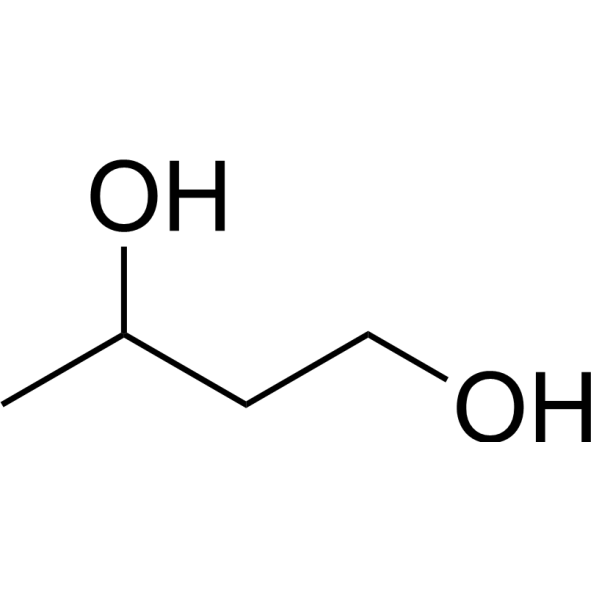| DC40294 |
neo-Inositol |
neo-Inositol, a stereoisomer of inositol, has been isolated from calf brain. |

|
| DC40398 |
α-D-Glucose-1-phosphate disodium hydrate |
α-D-Glucose-1-phosphate disodium hydrate is used as a starting material for synthesis of glucuronic acid. α-D-Glucose-1-phosphate disodium hydrate can be used as a cytostatic compound essential for cardiopathic therapy, as an antibiotic, as an immunosuppressive drug, and as a circulatory system therapy element. |

|
| DC40407 |
Fructosyl-lysine dihydrochloride |
Fructosyl-lysine (Fructoselysine) dihydrochloride is an amadori glycation product from the reaction of glucose and lysine by the Maillard reaction. Fructosyl-lysine dihydrochloride is the precursor to glucosepane, a lysine–arginine protein cross-link that can be an indicator in diabetes?detection. |

|
| DC40643 |
4-Formylaminoantipyrine |
4-Formylaminoantipyrine?is an excreted metabolite of?aminophenazone. Aminophenazone is a pyrazolone with analgesic, anti-inflammatory, and antipyretic effects in vivo. |

|
| DC40687 |
Dichloroiodomethane |
Dichloroiodomethane is a natural compound in human beings. |

|
| DC40740 |
trans-2-Hexadecenoyl-L-carnitine |
trans-2-Hexadecenoyl-L-carnitine is an endogenous metabolite in urine. |

|
| DC40741 |
[(3R)-3-Hydroxydodecanoyl]-L-carnitine |
[(3R)-3-Hydroxydodecanoyl]-L-carnitine is an endogenous metabolite. |

|
| DC40779 |
NHC-diphosphate |
NHC-diphosphate is an active phosphorylated intracellular metabolite of β-d-N4-Hydroxycytidine (NHC) as a diphosphate form. NHC is a pyrimidine ribonucleoside and behaves as a potent anti-virus agent. NHC effectively inhibits the replication of venezuelan equine encephalitis virus (VEEV), Chikungunya virus (CHIKV) and hepatitis C virus (HCV).
|

|
| DC40938 |
Ternidazole hydrochloride |
Ternidazole hydrochloride is a hydroxymetabolite of nitroimidazole, has antiprotozoic properties. |

|
| DC40939 |
Toltrazuril sulfoxide |
Toltrazuril sulfoxide is a short-lived intermediary metabolite of Toltrazuril, and then can be metabolized to the reactive toltrazuril sulfone (TZR-SO2) in vivo. Toltrazuril is an antiprotozoal agent that acts upon Coccidia parasites.
|

|
| DC40969 |
N-β-alanyldopamine hydrochloride
Featured
|
N-β-alanyldopamine hydrochloride, commonly referred to as NBAD hydrochloride, stands as the primary dopamine derivative found in haemolymph. |
.gif)
|
| DC41005 |
2'-Deoxyadenosine-5'-triphosphate |
2'-Deoxyadenosine-5'-triphosphate (dATP) is a nucleotide used in cells for DNA synthesis (or replication), as a substrate of DNA polymerase. |

|
| DC41006 |
2'-Deoxyadenosine-5'-triphosphate trisodium |
2'-Deoxyadenosine-5'-triphosphate trisodium (dATP trisodium) is a nucleotide used in cells for DNA synthesis (or replication), as a substrate of DNA polymerase. |

|
| DC41023 |
Noradrenaline tartrate |
Norepinephrine tartrate (Levarterenol tartrate), a naturally occurring chemical in the body that acts as both a stress hormone and neurotransmitter, is a β1-selective adrenergic receptor agonist with EC50 of 5.37 μM. |

|
| DC41147 |
Methyl phenylacetate |
Methyl phenylacetate is an endogenous metabolite. |

|
| DC41148 |
1,3-Butanediol
Featured
|
1,3-Butanediol, an ethanol dimer providing a source of calories for human nutrition. 1,3-Butanediol is converted in the body to β-hydroxybutyrate and has cerebral protective and hypoglycaemic effect. |

|
| DC41189 |
S-Adenosyl-L-methionine tosylate |
S-Adenosyl-L-methionine tosylate (S-Adenosyl methionine tosylate) is produced endogenously from methionine and ATP by action of the enzyme methionine adenosyltransferase and is an important orally active methyl group donor. S-Adenosyl-L-methionine tosylate is a dietary supplement with potent antidepressant and analgesic effects, and has the potential for liver disease and osteoarthritis research. |

|
| DC41192 |
Dehydroepiandrosterone sulfate sodium salt |
Dehydroepiandrosterone sulfate sodium salt (DHEAS) is the most abundant circulating steroid in human. Dehydroepiandrosterone sulfate sodium salt (DHEAS) affects steroid hormone biosynthesis on a molecular level resulting in an increased formation of pregnenolone. |

|
| DC41228 |
Allantoic acid |
Allantoic acid is a degradative product of uric acid and associated with purine metabolism. |

|
| DC41267 |
ATP dipotassium |
ATP dipotassium (Adenosine 5'-triphosphate dipotassium) is a central component of energy storage and metabolism in vivo, provides the metabolic energy to drive metabolic pumps and serves as a coenzyme in cells. ATP dipotassium is an important endogenous signaling molecule in immunity and inflammation. |

|
| DC41290 |
Indole-2-carboxylic acid |
Indole-2-carboxylic acid is a strong inhibitor of lipid peroxidation. Indole-2-carboxylic acid (I2CA) specifically and competitively inhibits the potentiation by glycine of NMDA-gated current. |

|
| DC41294 |
Lumisterol |
Lumisterol (9β,10α-Ergosterol), a steroid compound, is the (9β,10α)-stereoisomer of Ergosterol. Lumisterol is a photoprotective agent against UVB-induced DNA damage and anti-proliferative activities. |

|
| DC41297 |
D-Valine |
D-Valine is the enantiomer of L-Valine. L-Valine is one of 20 proteinogenic amino acids. L-Valine is an essential amino acid.
|

|
| DC41315 |
Propylparaben sodium |
Propylparaben sodium (Propyl parahydroxybenzoate) is an antimicrobial preservative which can be produced naturally by plants and bacteria. Propylparaben sodium is prevalently used in cosmetics, pharmaceuticals, and foods. Propylparaben sodium disrupts antral follicle growth and steroidogenic function by altering the cell-cycle, apoptosis, and steroidogenesis pathways. Propylparaben sodium also decreases sperm number and motile activity in rats. |

|
| DC41316 |
(S)-Higenamine |
(S)-Higenamine ((S)-Norcoclaurine), a S-enantiomer of Higenamine, is the entry compound in benzylisoquinoline alkaloid biosynthesis. (S)-Higenamine is produced by the condensation of dopamine and 4-hydroxyphenylacetaldehyde (4-HPAA) by norcoclaurine synthase (NCS). |

|
| DC41317 |
(S)-Higenamine hydrobromide |
(S)-Higenamine ((S)-Norcoclaurine) hydrobromide, a S-enantiomer of Higenamine, is the entry compound in benzylisoquinoline alkaloid biosynthesis. (S)-Higenamine hydrobromide is produced by the condensation of dopamine and 4-hydroxyphenylacetaldehyde (4-HPAA) by norcoclaurine synthase (NCS). |

|
| DC41372 |
O-Desmethylangolensin |
O-Desmethylangolensin is a metabolite of soy isoflavone, daidzein metabolized by gut microbiota. O-Desmethylangolensin possesses antioxidant activity. |

|
| DC41393 |
Nε,Nε,Nε-Trimethyllysine chloride |
Nε,Nε,Nε-Trimethyllysine chloride serves as a precursor for gut flora-dependent formation of N,N,N-trimethyl-5-aminovaleric acid (TMAVA). |

|
| DC41410 |
all-trans-Anhydro Retinol |
all-trans-Anhydro Retinol (Anhydrovitamin A) is a metabolite of Vitamin A. all-trans-Anhydro Retinol is used in synthetic multivitamin preparations. |

|
| DC41485 |
Orotidine 5′-monophosphate |
Orotidine 5′-monophosphate is a pyrimidine ribonucleoside and plays a role as an endogenous metabolite of human, E. coli or mouse. Orotidine 5′-monophosphate is an intermediate in the biosynthesis of?uridine monophosphate (UMP). Orotidine 5′-monophosphate can be used for the study of mechanism of orotidine 5′-monophosphate decarboxylase. |

|










.gif)


















